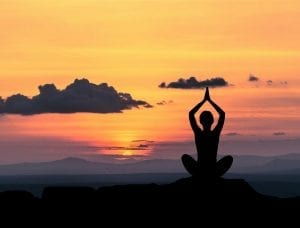Are you thinking about a yoga workout? No wonder, considering its benefits and popularity! Yoga works on two levels: mental and physical. Yoga is a mind and body practice combining various styles, body posture, breathing technique, meditation, and relaxation. The powerful mind-body-spirit transformation that yoga brings helps us counteract stress, fatigue, and poor self-image.
Bearing in mind all the stressful situations we come across every day, yoga is just what we need! We’ve prepared some fun Facts about yoga, both for the experienced yoga practitioners and the beginners, that’ll probably come in handy…
1. Yoga’s gone global.
The South Asian art of yoga has spread worldwide. Today yoga is a popular form of exercise and meditation.
2. It’s been around for a very long time!
The word “yoga” was first mentioned in Rig Veda, one of the oldest texts in the world.
The word yoga originated from the Sanskrit word “Yuj”, meaning “to join” or “to yoke” or “to unite”. According to yogic scriptures, yoga training leads to the union of individual and universal consciousness.
3. It has multiple benefits.
Yoga can cure your mind, body, and soul. It can also improve a lot of health issues.
However, yoga is like a double-edged sword, so if you don’t practice correctly, you could injure yourself. Therefore a good teacher is essential!
Other than decreasing stress, yoga helps lower blood pressure, reduce blood cholesterol, and blood glucose levels. A helpful lifestyle intervention, wouldn’t you say!

4. No one really knows who invented yoga.
There is no written evidence about the yoga inventor.
5. Yoga practitioners have been around for centuries.
Yogis, male yoga practitioners, and yoginis, female yoga practitioners both practiced and taught yoga long before any written account of yoga came into existence.
Yogis passed the discipline down to their students, over the next five millennia, and many yoga schools were developed as the practice extended its global grasp and popularity.
6. It’s at least two millennia old.
The 2,000-year-old guidebook “Yoga Sutra”, on how to master the mind, control the emotions, and grow spiritually was written by the Indian sage Patanjali. It’s the earliest written record of yoga and one of the oldest existing texts which provide the framework for all modern yoga.
7. It wasn’t all about health, to begin with.
Yoga postures and poses weren’t a key part of the original yoga traditions in India. Fitness was not the main goal. Practitioners and yogic tradition followers concentrated on other practices, such as increasing spiritual energy using breathing methods and mental focus.
8. That symbol didn’t always have negative connotations.
The original yoga symbol was the swastika, which originated from the word “Svastik”, meaning “that which is associated with well-being.”
9. It spread to the west in the 1800s.
At the end of the 19th century, yoga began to gain popularity in the west.

10. It became huge in the 1920s and 1930s.
In the 1920s and 1930s there was an immense interest in postural yoga, first in India and later in the west.
11. Tree symbolism plays a big part.
Yoga often uses the imagery of a tree with roots, a trunk, branches, blossoms, and fruits to transfer its spiritual message and guide sessions. Each “branch” signifies a different focus and characteristics set.
12. Here are some facts about the branches.
There are six yoga branches: hatha yoga, raja yoga, karma yoga, bhakti yoga, jnana yoga, and tantra yoga.
The physical and mental branch intended to prime the body and mind is hatha yoga.
Raja yoga includes meditation and strict devotion to a series of disciplinary steps known as the “eight limbs” of yoga.
Karma yoga is a pathway of service that aims to produce a future free from negativity and selfishness.
Bhakti yoga aims to create the path of devotion, a positive way to channel emotions and nurture acceptance and tolerance.
Jnana yoga is all about wisdom, the pathway of the scholar, and increasing the intellect through study.
Tantra yoga is the path of ritual, ceremony, or consummation of a relationship.

13. It’s all about energy.
Yoga supports the fact that chakras are centre points of energy, thoughts, feelings, and the physical body.
14. Emotions, too, play a major role.
Yogic teachers believe that chakras define how people experience reality through emotional feedbacks, needs or dislikes, levels of self-confidence or fear, and even physical symptoms and effects.
15. What are asanas?
The many physical positions in hatha yoga are known as asanas. People practicing yoga use asanas to release their energy and stimulate an imbalanced chakra.
Asanas also help you increase your flexibility, muscle control, and strength, helping your entire physical condition. A few asanas and your sex life will be blooming!

16. There’s a very famous yoga position.
Asanas are originally practiced to empower the yogi to sit in the famous yoga cross-legged position and meditate for hours without feeling his or her body stiffen or hurt.
17. Millions and millions of people do yoga.
An estimated 300 million people are partaking in yoga, using their physical, mental, and spiritual nature.
18. Could yoga help keep you young?
Research suggests that yoga, along with meditation, can help postpone the aging process. So, if you want to stay young, don’t hesitate, become a yoga practitioner!

19. The gender balance has tipped.
Today in the west, yoga is mainly dominated by women, while until 1937 it was a male-only practice.
20. What is a chakra, anyway?
The word “chakra” means “spinning wheel”.
When the energy has been blocked in a chakra, it is thought it triggers physical, mental, or emotional imbalances that manifest in the following symptoms: anxiety, lethargy, or poor digestion.
21. Yoga health benefits are actually provable.
Many researchers claim that practicing yoga regularly increases your immune system.

22. It’s really branched out!
Now, there are over 100 different yoga, including goat yoga, nude yoga, and broga – yoga.
23. What does ‘om’ mean?
As the syllables, A-U-M represents the past, present, and future respectively, the practice of chanting “Om” at the beginning and end of a session creates the sound of the universe. It’s meant to conjure a connection with the “bigger picture”’, all the things within and around us.

FAQs about Yoga
Is yoga bad for you?
Only if you don’t stretch carefully or look after yourself while practicing! You can injure yourself while undertaking yoga.
Can you lose weight through yoga?
Yes, it’s entirely possible to lose weight with yoga, but you need to combine it with other exercises!
When shouldn’t I practice yoga?
Yoga should never be practiced when you are feeling ill or when you are tired.
Do you know any fun facts about yoga? Share them in the comments below!










